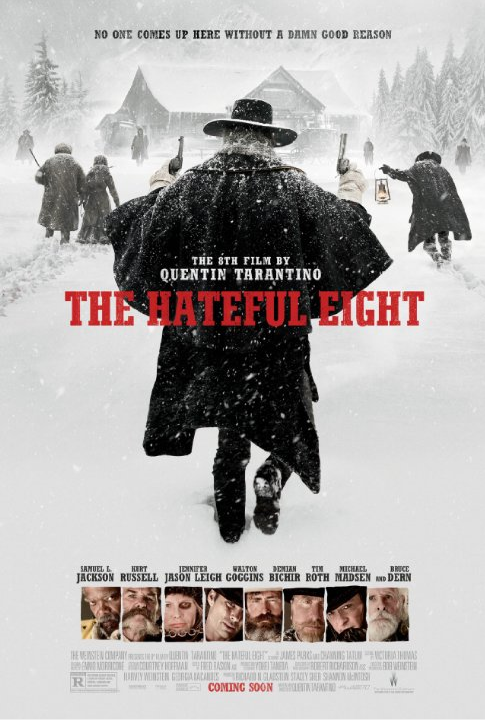film review: the hateful eight
Set sometime after the Civil War, and apparently contained within the same universe as 2012’s Django Unchained, Quentin Tarantino’s The Hateful Eight introduces us to Major Marquis Warren (Samuel L. Jackson), a bounty hunter on route to the town of Red Rock to cash in on his deadly efforts. But on this cold day in mountainous Wyoming, Warren becomes stranded in a raging blizzard: his horses are frozen to death and his bounties lay bound within plumes of thick snow. Until a stagecoach arrives.
The infamous John ‘The Hangman’ Ruth (Kurt Russell) and his $10,000 bounty Daisy Domergue (Jennifer Jason Leigh) are, to Warren’s luck, also on course to Red Rock where Daisy is expected to hang – and by God, if John Ruth ‘The Hangman’ catches you: you hang. We’re also introduced to an equally stranded, and all the more desperate, Chris Mannix (Walton Goggins), a Southern man with proud Union roots, who conveniently claims to be Red Rock’s new sheriff.
Within a worsening snowstorm, these travellers find refuge at Minnie’s Haberdashery, a halfway safe haven that has otherwise become inhabited by a rather nefarious bunch: a suspiciously quiet writer Joe Gage (Michael Madsen), the Haberdashery’s upkeep Bob (Demián Bichir), a discreet General Sandy Smithers (Bruce Dern) and the man whose rope will soon find Daisy’s throat, Red Rock’s perfectly poised, English hangman Oswaldo Mobray (Tim Roth).
This one setting-staged retreat stands as the perfect breeding ground for tensions to flare and suspicions to run wild in claustrophobic madness. Fortunately, we experience the brewing chaos through Major Warren’s vigilant point of view, a perk that proves crucial in picking up on any inkling of sly behaviour, or on the scattered discrepancies that riddle the Haberdashery, signaling evidence of foul play.
Now, we have this group of deadly no-goods, holed up in Minnie’s during an unwelcomed snowstorm; a very guarded John Ruth, who is ever-protective of his pricey bounty; and every chance of things turning sour, which, as Tarantino’s fate would have it, eventually does. And so, The Hateful Eight rapidly forms as a very deadly game of whodunit – one that relies on two main vices to build its intrigue: its wordy dialogue and its gore.
Words play a particularly integral role to the story’s development – an observation that seems obvious and somewhat necessary for most narrative progressions, but for The Hateful Eight, each lengthy squabble that precedes the next totally determines the fate of each hateful soul.
Words can be weapons for those who know how to use them, and can prove more deadly than the guns holstered by a character’s side. And so, as the token Tarantino star so often does, one does not simply get to the point. They walk around it a few times, pick and prod until each detail is meticulously drawn out, details that are as colourful, imaginative and offensive as ever. This feature also grants us, if nothing else, a tiny insight into the mind of an arguably sadistic genius – and, pays off: whether in a sharp, and downright badass, punch line or in a gruesome and explosively bloody end to a no-good who had it coming.
But that’s not to say The Hateful Eight is perfect. There are problems, namely with character inconsistencies and a lingering feeling that this enigmatic bunch still lacks that something special. This, however, does add to their mystique: surely dubious thugs that should not be trusted. With that said, this intrigue relies upon on a particularly male-centric cast to deliver the fabled Western tale of the always-masculine outlaw who battles to reclaim political justice from the scum of a merciless land. The genre also allows Tarantino to take issue against tricky themes of race and the unjust manner in which nineteenth-century America regrettably developed itself. The Hateful Eight proves not as groundbreaking as Django, despite the director’s somewhat commendable attempts to engage with a complicated issue.
But it is the single female beacon within the center of this brutal war of words and bullets that shines the brightest. Daisy Domergue emerges as the coolest of the bunch: gritty, tough and more unforgiving than the lot. For this, credit is due to Leigh’s outstanding performance, which has deservedly led to a Best Supporting Actress nod in the upcoming Oscars.
It’s important to also comment on the film’s length, which totals just over three hours (with an overture and an intermission for the authentic cinema experience!). This could play against the film’s favour in securing mass appeal – the drawn out conversations may seem more like an endurance contest than a treat for those not aligned with the Tarantino die-hards.
That said, this is Quentin Tarantino’s grand epic, a feat in the making; one that has been achieved in glorious 70mm: a beautifully warm toned and seldom out of focus spectacle of grandeur that is as large and as overwhelming as the trademark ego of its eccentric director. And this is precisely where most of The Hateful Eight derives its charm. It is Tarantino’s ode to cinema, but this time, it’s more than pure allusion; it’s a technical achievement of cinematic history being delivered on the same film as 1959’s Ben-Hur and Stanley Kramer’s It’s a Mad, Mad, Mad, Mad World (1963).
So it only seemed fitting – an absolute necessity – that the legendary Ennio Morricone should score such a sentimental project. His signature touches lend the film a classically familiar experience. The barrage of sounds simply overwhelms the senses as they rumble and roar atop a dazzling cinematographic backdrop of bleached white snow or a trail of ruby, red blood.
This is, in its simplest, an undeniably exciting experience filled with all the Tarantino essentials sure to satisfy fans and film buffs alike. See it in 70mm if you can.



Pingback: The Hateful Eight – Film Review | Giuliana Cincotta